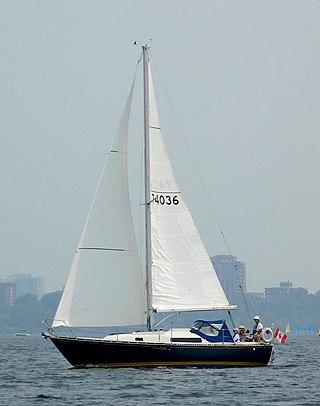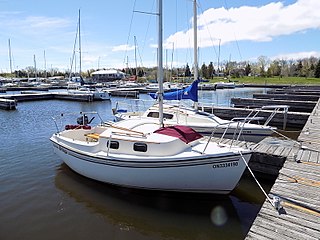The Newport 16 is an American trailerable sailboat that was designed by Bill Lapworth as a daysailer and a pocket cruiser and first built in 1965.

The Catalina 22 is an American trailerable sailboat that was designed by Frank V. Butler and first built in 1969.

The Com-Pac 16 is an American trailerable sailboat that was designed by Clark Mills as a small cruiser and first built in 1972.

The Swan 56 is a Finnish sailboat that was designed by Germán Frers as a blue water cruiser-racer and first built in 1996. A racing oriented version was designated as the Swan 56R for Regatta.

The C&C 30 is a series of Canadian and American sailboats, that was first built in 1973.
The Redline 41 is a series of sailboat designs, first built in 1967 and that remained in production in 2017. The first two designs were by Cuthbertson & Cassian and the more recent one by Mark Mills.

The Sanibel 18 is an American trailerable sailboat, that was designed by Charles Ludwig, first built in 1982 and named for the Floridian town and island.

The Hunter 27 is a series of American sailboats, that were first built in 1974.

The Sirius 20, 21 and 22 are a family of Canadian trailerable sailboats that was designed by Hubert Vandestadt for cruising and first built in 1976.
The Holder 17 is an American trailerable sailboat that was designed by Ron Holder as a pocket cruiser and day sailer and first built in 1982.
The Aquarius 23 is an American trailerable sailboat that was designed by Peter Barrett and Stan Miller as a cruiser and first built in 1969.
The Aquarius 21 is an American trailerable sailboat that was designed by Peter Barrett as a cruiser and first built in 1969.
The Com-Pac 23 is an American trailerable sailboat that was designed by Clark Mills as a pocket cruiser and first built in 1978. The boat has undergone design changes over time resulting in a series of improved models.
The Cornish Crabber 24 is a series of British trailerable sailboats, designed by Roger Dongray as cruisers and first built in 1974.
The Ericson 25+, also called the Ericson 25 Mark II, is an American trailerable sailboat that was designed by Bruce King as a cruiser and first built in 1978.
The ETAP 21i is a Belgian trailerable sailboat that was designed by Mortain & Mavrikios as a cruiser and first built in 1997.
The Classic 22 is a Canadian trailerable sailboat that was designed by George Harding Cuthbertson of C&C Design, as a racer, daysailer and overnighter, first built in 1962.
The S2 6.7 Grand Slam is an American trailerable sailboat that was designed by Don Wennersten as a racer-cruiser and first built in 1980. The designation indicates the approximate length overall in meters.
The Signet 20 is a British trailerable sailboat that was designed by Ray Kaufmann as day sailer and pocket cruiser and first built in 1960.
The Windrose 22 and Laguna 22 are a series of American trailerable sailboats that were designed by W. Shad Turner as cruisers and first built in 1977.







